DIY fabric flowers
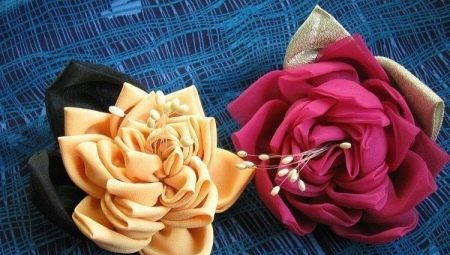
Do-it-yourself fabric flowers can be a great addition to interior decor, decorate a gift wrap or update an old bag, a boring outfit. Large buds made of denim rags, stylish chrysanthemums using the kanzashi technique and other ideas may well inspire even a person who has not held a needle in his hands for a long time to independent creativity. A detailed story about how to make them for beginners step by step through the master class will help you better understand the technology for creating such decorations and decor elements.
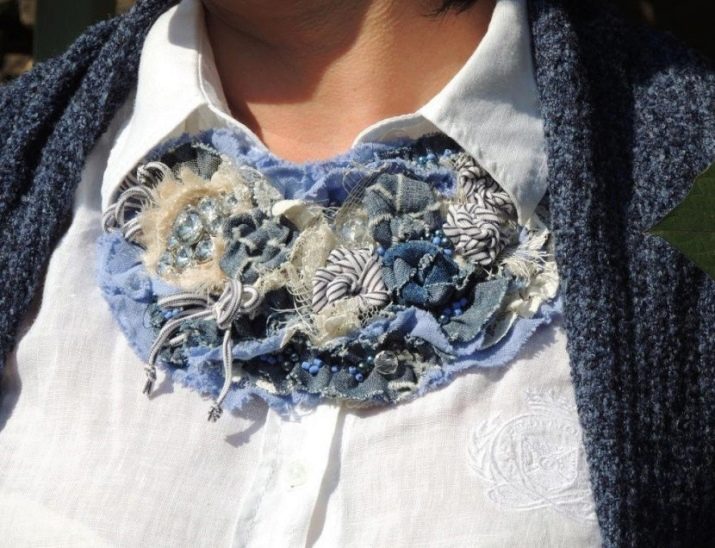





How to make roses from satin ribbons?
When deciding to make flowers from fabric with your own hands, you should start with the simplest master classes for beginners. This category also includes instructions for making roses from satin ribbons step by step. For 1 flower, 16–20 pieces of 7 cm long are required.
The order of work will include 4 steps.
- Burn the edges of the blanks with fire so that they do not creep.
- Bend the edge of 1 segment 2-3 times, roll it up with a tube and fasten it with a thread, without cutting it. You will get a central bud.
- Form petals. To do this, each segment is folded inward diagonally, then again (to the middle) and again, then superimposed on 1 half. Connect the bud and 3 petals in series with a thread. It is necessary to superimpose the elements on top of each other in halves, wrapping around the core.
- Collect the flower. For this, circles of 3, 5 and 7 petals are separately formed. Then the bud is glued with a heat gun into the smallest ring. Then a closed chain of 5 and 7 petals is attached around.
Finally, a green felt circle and leaves are glued to the back of the rose.The finished flower can be used to decorate a bag, hair band or napkin rings.






Making using the kanzashi technique
For home decoration or for an outfit, you can create simple but spectacular flowers from scraps of synthetic fabric (satin, rayon). They are suitable as a decoration for curtain holders, fabric bags or hair ties. This technique, which is easy even for beginners, produces beautiful brooches for a dress.
We describe the scheme for making kanzashi flowers below.
- Cut the tapes into equal squares. Their number should correspond to the number of petals.
- Fold the blanks diagonally twice to form a triangle. Glue the edges or burn them with fire. If the petals are needed rounded, fold the square in half, fold the corners to the center, and pull the sides back. Fastening is similar to triangular petals.
- Collect the flower. It will be easier to do this on a thick green felt mug. The petals fold in a circle to form a flower. On the sides, you can glue the leaves. In the middle, place a beautiful bead, a large rhinestone or a special finished piece that imitates stamens.
Flowers using the kanzashi technique are usually made lush, voluminous. Chrysanthemums with sharp petals or roses, peonies look especially impressive in this case.



More ideas
Fabric flowers - in the form of an applique or a brooch - are widely used in handmade culture. With their help, you can add uniqueness to banal and boring bags, revive the lapel of a jacket or short coat. Both vintage artificial bouquets, reminiscent of a boutonniere, and voluminous products that cling to the belt or cut of the dress look interesting. You can attach them to clothes using a safety pin; textured flowers made from remnants of fabric are perfect for interior decoration - simple but stylish, placed on the wall. Small flowers are suitable for children, they will surprise them with beautiful headbands or hairpins - any option is easy to do according to the instructions with your own hands.





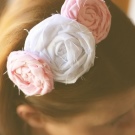
Organza
Lightweight translucent organza is a great base for creating flowers. It is quite tough, holds its shape well, and is easily processed. Finished flowers do not crumple from it. The fabric can be plain or gradient dyed, matte and shiny. Flowers can be made according to several schemes - each is worth considering in more detail.



Method number 1
In this case, organza flowers are made as described below.
- Cut out blanks. You will need 1 circle with a diameter of 60-80 mm and 5 with a size of 80-120 mm.
- Lightly burn the edges of each part with fire so that they are slightly bent. The work is carried out in a circle with the rotation of the element in the hands.
- Cut all the circles, forming petals - 4-6 pieces will be enough. Flame the cut sites.
- Form the stamens from the yellow threads. It is enough to wind them on 2 connected fingers in 10 turns, then tie them in the center and cut the loops along the edges. Fluff up.
Collect the flower. The smallest circle will be the top one in the stack. Stamens are embedded in the center. The flower is held together with threads.



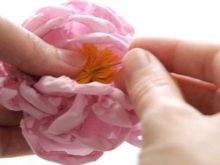


Method number 2
In this case, it will take a little more effort. Templates for petals of 3 sizes are made of cardboard: large (24 elements are cut from organza), medium (16 parts), small (6-9). You can take a living flower as a basis, disassemble it and outline the necessary parts on thick cardboard. Organza petals are processed with fire along the edges.
Then you need to follow the instructions.
- A needle with a thread threaded into it is stuck into a block of polystyrene.
- Parts of the flower are successively strung on the tip. First, the largest ones are attached in a circle (with layering), then medium and small ones.
- The product is sewn with a needle in the center at the end of the assembly. In the middle, stamens or large beads are attached to cover the assembly site.
Organza is a material that looks very impressive in the interior of the house. The resulting flowers can be used to decorate curtains or walls, complement a tablecloth or sofa cushions.They will look no less stylish on a hat or dress, in the form of a brooch.


Denim
Denim is a cotton material considered to be quite boring. But with certain efforts, you can easily create flowers from it that can compete in beauty with living roses. Denim trims can be replaced with linen, rayon, burlap or velvet scraps. Depending on the choice of fabric, the appearance of the craft will also change.



Working with textiles is carried out according to 1 of 2 schemes.
- In the first case, denim scraps are cut into strips of 20 × 200 mm. They are rolled up with a small amount of quick-drying glue. The flower is collected from blanks, laying them out in a circle, sewn with threads. It is easy to decorate the finished bud with beads or beads, sequins or other types of decor.
- In the second case, it is better to choose soft denim or linen for creativity, you can add lace to the material. The prepared strips are folded in half along the length, a corner is bent and tucked on one side. Then the strip is wound around the central part, twisting it with a tourniquet, the end is glued from the inside out.
Denim flowers look good in combination with wardrobe items and accessories in the style of hippie, provence, country or boho. They can decorate tops of boots, belts, sidewalls of bags, jackets or headbands.

With felt
When creating beautiful designer flowers from fabric, it is impossible to resist the temptation to work with felt. This material is especially good for beginner needlewomen. It does not require special processing, it can be easily cut without crumbling. The simplest version of a felt flower is a chrysanthemum, which is made according to the instructions below.
- Cut out long strips of felt about 40 mm wide.
- Bend the workpieces in half. The result will be strips 20 mm wide. Pin them lengthwise.
- Make cuts along the fold line without reaching the end. The distance between them should be 3-5 mm.
- Free the resulting workpiece from the pins. Roll up into a ring. Fasten with a thread and a needle.
- Stick on the green round base from the wrong side.
- Glue or sew a semicircular button into the middle on the front side. You can also make a small felt lining under it.

A felt rose looks no less impressive. The blank for it is cut out of the circle in waves in a spiral. Then you just have to roll it up tightly, add a center bead.
These felt roses are well suited for decorating gift wrapping.


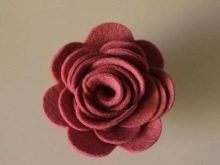
From foamiran
Large flowers made from isolon and foamiran have become popular in the interior decor. They have a height of 1 to 3 meters, perfectly complement the living space in a country house, but can also be installed in boutiques, banquet halls, photo studios. Foamiran is very similar to fabric in its properties, but it is much easier to clean, cut out, and gather into large shapes. This material can also be found commercially under the name revelor or faux suede in a wide variety of colors and shades.
For the interior, it is easiest to make tall flowers-lamps in the form of large poppies or calla lilies, lilies with a shade for a lamp or an LED instead of stamens. It will be enough to cut out large petals in the desired quantity. Foamiran, if necessary, can be easily painted with pastel, if part of the petal should be dark or light.
Then a wooden stand is made, the stems-holders are cut from izolon. Flowers are collected on the ground. The lamp is connected to a wire with a plug and is installed in the interior. A beautiful decorative lamp is ready.

From chintz
Light natural fabrics are perfect for decorating children's clothing. Chintz in delicate shades is quite easy to turn into a flower if you cut it into long strips. Then the work takes place according to a certain scheme.
- The ribbons are folded in half lengthwise.
- Sewn along the edges with a slight bend inward.
- Basting with large stitches along the edge of the sewn edge. The thread needs to be pulled slightly, creating folds, and secure.
- Lay the resulting workpiece in a circle in layers, narrowing each subsequent tier. The longer the strip, the more magnificent the flower will turn out.
- The edge of the tape is fixed in the center. A large bead or button is sewn over it.
The print flower decoration for the girl's dress or blouse is ready. Several such elements can be used to decorate a drawstring belt or complement the ties on a blouse.

Fleece or satin tulips
These flowers are created using the tilde technique - one of the most popular in patchwork. The finished products are very delicate and beautiful. They can become a real decoration of the spring table, and collected in a bouquet in a round paper cup turn into an excellent substitute for fresh flowers as a gift.
It is better for beginners to make tulips according to the scheme.
- The prepared fleece or satin is cut according to the template to the scale of the original. You will need a stem, leaves (2-3 pieces), a bud.
- Each piece is sewn from the inside out, turned inside out, stuffed with cotton wool.
- Finished elements are hemmed.
- The flower is going.



When making tilde tulips, the density of the stuffing is very important. If in the leaves it only slightly gives shape, then in the buds and stems the filler must provide elasticity and volume. Tulips from fabric in a small cage or with a light print in pastel colors look great. Bouquets of 5–7 tulips look best - they turn out to be very delicate and decorative.
Not all types of fabrics are suitable for working in the tilde technique. If the workpieces are cut out of synthetic materials (satin, viscose), the edges should be singed first, otherwise the fabric will "creep" over time. The seams will not hold firmly. Chintz, latex or foamiran are also poorly suited for work.


For information on how to make a flower from fabric, see the next video.








